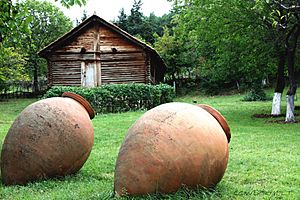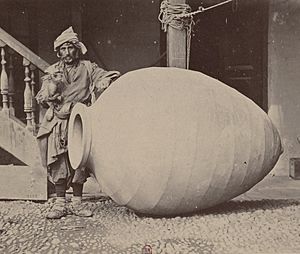Kvevri facts for kids
Kvevri or Qvevri (Georgian: ქვევრი) are large earthenware pots. People in Georgia use them to make, store, and age traditional Georgian wine. In Western Georgia, they are also called Tchuri (Georgian: ჭური).
Kvevri look like big, egg-shaped pots without handles. They are usually buried underground or placed into the floors of wine cellars. Kvevri come in many sizes. They can hold from 20 litres to about 10,000 litres. A common size holds about 800 litres.
Contents
Ancient History of Kvevri Winemaking
Scientists have found very old Kvevri and grape seeds. These were found in southern Georgia, in places like Dangreuli Gora and Imiri village. These discoveries show that people were using Kvevri to make wine about 8,000 years ago. This makes Georgia one of the oldest wine-making regions in the world.
How Kvevri Pots are Made
Some villages in Georgia are famous for making Kvevri. These include Atsana in Guria; Makatubani, Shrosha, Tq'emlovana, and Chkhiroula in Imereti; and Vardisubani in Kakheti. Families in these areas have passed down the special skills to make Kvevri for many generations.
The clay used to make a Kvevri is very important. It must be chosen carefully. The type of clay can change the minerals in the wine.
Making Wine in Kvevri
Making wine in Kvevri involves a special process. First, grapes are pressed. Then, the grape juice, skins, stems, and seeds are poured into the Kvevri. The pot is then sealed.
The juice stays in the Kvevri to turn into wine. This takes at least five to six months. After this time, the wine is taken out and bottled. The leftover grape parts (like seeds, skins, and stems) are called chacha in Georgian. This chacha can also be made into a strong drink called brandy.
After the wine is removed, the empty Kvevri is cleaned. It is washed and made germ-free with lime. Then, it is coated again with beeswax. This makes it ready to be filled with new wine.
Different Styles of Kvevri Wine
Traditional Georgian wines are not all the same. A common thing is that they are made in Kvevri buried completely underground. Even the opening of the pot stays below the ground.
Kakhetian Method
One very old and unique style is the white Kakhetian wine. This wine is also known as orange or amber wine. It is made by leaving the grape skins, seeds, and stems in the Kvevri for several months. This method is called the "Kakhetian method." It gives the wine a strong taste and color.
Imeretian Method
Another style is the "Imeretian method." This method is a bit different from the Kakhetian one. It uses less of the leftover grape parts (chacha). Also, the stems are not used at all. The rest of the winemaking process is similar. Wines made with the Imeretian method are often closer to wines you might find in Europe. They are not as strong in taste as the traditional Kakhetian wine. However, aging them in Kvevri still gives them a special Georgian touch.
Kartli Method
There is also a traditional white wine from the Kartli region in Central Georgia. This method is somewhere between the Kakhetian and Imeretian styles. For Kartli wine, about one-third of the chacha (including stems) is added to the Kvevri.
Other Uses and Benefits
In the past, Kvevri were used for more than just wine. People also stored brandy, grain, butter, cheese, and other foods in them. But in Georgia, they have always been mostly used for making wine.
Large ceramic storage pots like Kvevri are made in many countries. However, only Georgia, Spain (where they make vino de tinaja), and Portugal (where they make vinho de talha) use them for making wine.
Winemakers who use Kvevri say their wine is naturally stable. It is rich in tannins, which are natural compounds. These tannins help the wine last a long time and taste good without needing many added chemicals. Tannins in Kvevri wine also help keep it clear and prevent it from becoming cloudy.
Global Recognition and Revival
For a while, Georgia sold less wine to Russia. This led Georgia to bring back its old way of making wine. Now, Kvevri winemaking is getting attention around the world. Many wineries in Georgia export Kvevri wines to other countries. Some winemakers in Europe and America have also started using Kvevri.
The tradition of making wine in Kvevri was officially recognized in Georgia in 2011. In 2013, UNESCO added the traditional Georgian method of making wine in Kvevris to its list of world intangible cultural heritage. This means it is seen as an important part of human culture.
Spelling
The Georgian language has two 'k' sounds. One is like the 'k' in English. The other is a special 'ejective' 'k'. The word kvevri (Georgian: ქვევრი) uses the normal 'k'.
However, when Georgians type their language on a computer, the key for this 'k' is often the 'q' key. Because of this, Georgians often spell the word with a 'q' in English. So, you will often see it written as "Qvevri." This spelling is now very common, even in official documents like those from UNESCO.
See also
 In Spanish: Tinaja Kvevri para niños
In Spanish: Tinaja Kvevri para niños





